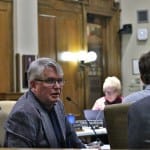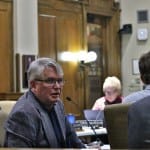Big meeting makes little progress on convention center expansion agreement, smaller group to try again




In three weeks, a group of four city and county officials will try to achieve what a larger group of 13 electeds could not accomplish on Monday night.
Monday’s meeting was the third one this year that has tried to build on some momentum from December, when Bloomington and Monroe County officials finally agreed that a capital improvement board (CIB) would provide the governance structure for the project.
If the details can be worked out, the idea is for the county commissioners to create a CIB, so that an architect can be put under contract for the design and construction phase of a planned $44-million convention center expansion project.
The project has been stalled over governance issues for nearly 10 months—since May 19 last year when a steering committee voted to recommend a northward expansion of the convention center.
The next public meeting, now pencilled in for March 23, will include just one county councilor, one city councilmember, one county commissioner and Bloomington’s mayor.
The four will try to hammer through the points of disagreement about the four-way interlocal agreement that is supposed to help guide the governance of the convention center expansion project.
The interlocal agreement is supposed to cover the operations of a yet-to-be-created capital improvement board (CIB) and the existing convention and visitors commission (CVC).
Known points of friction going into Monday’s meeting were the mechanisms for making appointments to the CVC and the contributions of land by the city and the county to the project. On Monday, additional points of disagreement emerged involving some proposed additional wording about the sustainability of the convention center’s design.
At the previous meeting of city and county officials, on Feb. 10, the mechanism for making appointments to the CVC seemed close to being solved.
The nuance related to the CVC is that under the state statute, the power to make some of those appointments rests with the county council. County councilors want to make sure the interlocal agreement does not cede their power to the city of Bloomington.
Considered at Monday’s meeting was some proposed wording, which had been crafted by the county and city legal teams, that involved the city making a recommendation, with the county council having the option to “veto” that recommendation and to ask for a different one.
The word “veto” was a sticking point. And city councilmember Isabel Piedmont-Smith identified some lack of clarity. So the lawyers will take another shot at that wording on CVC appointments.
With respect to the land parcels, the county’s position, expressed at the previous meeting, was that each side should contribute to the CIB the land they own that is known to be needed for the project—as it’s currently conceived based on the preliminary site plan selection done last year.
In contrast, the city’s position on the real estate had been that the county should contribute to the CIB all the parcels it has purchased with the county’s innkeeper’s tax in anticipation of a convention center expansion, even if those parcels are not immediately called for in the preliminary site plan. The parcels the county does not necessarily want to contribute are to the south and the west of the current convention center site.
The city wants the county to contribute those parcels to the CIB, because of the county’s argument that the innkeeper’s tax helps put the county on “equal” footing with the city, which is using its share of the food and beverage tax to pay for the convention center expansion. The county is putting its share of the food and beverage tax towards a different project, involving a limestone heritage site.
If it’s the innkeeper’s tax that puts the county and city on equal footing, then everything purchased with the innkeeper’s tax should go into the CIB—that’s the city’s position.
At Monday’s meeting, Bloomington’s mayor John Hamilton acknowledged that the two sides didn’t agree on the land question. So he pitched the idea of avoiding the conflict now and leaving the question for the CIB to negotiate with the city and the county, after the CIB is formed. The CIB would have to come to the county to ask for land and to the city to ask for land and money, Hamilton said.
The proposed wording about the county and the CIB reads in part, “The County shall negotiate in good faith with the CIB for transfer of the ownership of the properties…” Similar wording applies to the city.
On Monday, president of the board of commissioners, Julie Thomas, saw little difference in saying no to the city about the transfer of the additional properties now as opposed to saying no to the CIB sometime in the future.
Thomas and other commissioners could not conceive of a possible application of the south parcels to a convention center expansion, given that the steering committee had last May recommended a northward expansion.
Commissioners asked Hamilton if there was some period of time after which the county would not have to negotiate the transfer of the southern parcels to the CIB, adding that they’d had been discussing other uses for it. That piqued Hamilton’s curiosity, and he asked what uses for the land the commissioners were considering. Commissioner Penny Githens responded to Hamilton by saying she was not comfortable talking about hypotheticals.
One indicator of how chippy the back-and-forth on the land question got: Thomas told Hamilton that if he wanted to take the northern property off the table, he should just say so. Hamilton told Thomas that wasn’t what he was saying. (The northern parcel is the Bunger & Robertson property, which the city purchased last year.)
When county attorney Margie Rice tried to identify the land immediately to the north and to the east, as well as the existing convention center at 3rd Street and College Avenue, as real estate the two sides agreed they should contribute, Hamilton said he did not appreciate Rice’s attempt to characterize what the city was agreeing to.
In addition to appearing even more sharply divided on the land question, city and county officials on Monday found an additional point of friction. City councilmember Matt Flaherty and county councilor Kate Wiltz crafted some language about the sustainable design components of the convention center expansion. The concluding sentence reads:
If sustainability actions are cost-effective over their lifetime and/or clearly to the overall benefit of the public, but require greater upfront capital expenditures than traditional courses of action, the parties agree to explore funding strategies to pursue these actions.
County Councilor Eric Spoonmore reacted to the idea that taxpayers could be paying more by saying that taxpayers were already being asked to shoulder enough of a burden.
On Monday, the idea that the the convention center should incorporate sustainable design found agreement around the table. Finding less agreement was how that should be expressed in the interlocal agreement.
Thomas said she felt there was general agreement on the concept, but there was a question about how to pay for it.
City councilmember Isabel Piedmont-Smith characterized the dilemma as a “rock and a hard place.” If the interlocal agreement says the convention center expansion has to be built to a LEED gold standard, what happens if there’s not enough money to do that? On the other hand, Piedmont-Smith said, if that kind of language is not included in the interlocal agreement, she wondered what would make the CIB try hard to achieve a sustainable design.
The group’s discussion on Monday about the sustainability components of the convention center itself was complemented by an additional proposal from city councilmember Matt Flaherty. He proposed to include in the interlocal agreement a description of transportation options, tied to the provision of parking for the project.
The final sentence of Flaherty’s proposal drew some scrutiny:
The total cost of ownership of any publicly owned, structured parking (including debt service, operations, and maintenance), shall be paid for solely through revenues and not through tax dollars.
City councilmember Jim Sims pointed out that the financing of the project involved various sources of revenues that would be pledged to pay for the bonds, in order to get the best bond rate.
Flaherty said he would be content to make that statement somehow aspirational instead of imposing it as a requirement.




Comments ()